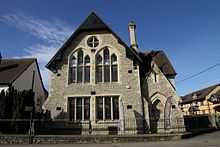Edward George Bruton
| Edward George Bruton | |
|---|---|
| Died | 1899[1] |
| Nationality | British |
| Occupation | Architect |
Edward George Bruton was a British Gothic Revival architect who practiced in Oxford. He was made an Associate of the Royal Institute of British Architects (RIBA) in 1855 and a Fellow of the RIBA in 1861.[1]
Work
- Saint Sepulchre's Cemetery, Oxford: lodge (undated, cemetery opened 1849)[2]
- Saint Paul, Walton Street, Oxford: added apse, 1853[3]
- Town Hall, Banbury, Oxfordshire, 1854[4]
- Saint Nicholas, Islip, Oxfordshire: restoration, 1861[5]
- 62 Banbury Road, Oxford: house, 1864–65[6]
- Christ Church Old Buildings, The Hamel, Oxford: tenement block, 1866[7]
- Saint Mary, Black Bourton, Oxfordshire: restoration, 1866[8]
- 64 Banbury Road, Oxford: house, 1868–69[9]
- Chapel of Cowley Middle Class School, Oxford Military College, Cowley, Oxfordshire, 1870
- Saint John the Evangelist, New Hinksey, Oxfordshire: church, 1870 (demolished 1900)[10]
- Saint Bartholomew, Ducklington, Oxfordshire: restoration, 1871[11]
- Rewley House, Wellington Square, Oxford: house, 1872[6]
- Saints Peter and Paul, Broadwell, Oxfordshire: restoration, 1873[12]
- Saint Nicholas, Emmington, Oxfordshire: enlarged rectory, 1873[13]
- Saint Mary, Hardwick, West Oxfordshire: rebuilt church, 1874[14]
- Saint John the Baptist, Stadhampton, Oxfordshire: rebuilt church and added south aisle, 1875[15]
- Saint Michael's Infants' School, New Inn Hall Street, Oxford, 1876[2]
- Saint Mary, Chipping Norton, Oxfordshire: vicarage, 1880[16]
- The Grange, Little Tew, Oxfordshire: new wing, 1880[17]

St Edburg's Hall, London Road, Bicester, built in 1882
- St Edburg's Hall, London Road, Bicester, Oxfordshire: 1882[18]
- Saint Bartholomew, Holton, Oxfordshire: vicarage, 1882[19]
- Saints Peter and Paul, Aston Rowant, Oxfordshire: restoration, 1884[20]
- Saint Andrew, Oddington, Oxfordshire: restoration, 1886[21]
- All Saints, Spelsbury, Oxfordshire: remodelled rectory, 1886[22]
- Covered Market, High Street, Oxford: roofs, 1886–97[23]
- Saint Mary, Souldern, Oxfordshire: rectory, 1890[24]
References
- ↑ 1.0 1.1 Brodie 2001, p. 284.
- ↑ 2.0 2.1 Sherwood & Pevsner 1974, p. 325.
- ↑ Sherwood & Pevsner 1974, p. 295.
- ↑ Sherwood & Pevsner 1974, p. 437.
- ↑ Sherwood & Pevsner 1974, p. 664.
- ↑ 6.0 6.1 Tyack 1998, p. 236.
- ↑ Sherwood & Pevsner 1974, pp. 238–239.
- ↑ Sherwood & Pevsner 1974, p. 458.
- ↑ Sherwood & Pevsner 1974, p. 319.
- ↑ Sherwood & Pevsner 1974, p. 335.
- ↑ Sherwood & Pevsner 1974, p. 589.
- ↑ Sherwood & Pevsner 1974, p. 489.
- ↑ Sherwood & Pevsner 1974, p. 492.
- ↑ Sherwood & Pevsner 1974, p. 633.
- ↑ Sherwood & Pevsner 1974, p. 776.
- ↑ Sherwood & Pevsner 1974, p. 539.
- ↑ Sherwood & Pevsner 1974, p. 691.
- ↑ Sherwood & Pevsner 1974, p. 456.
- ↑ Sherwood & Pevsner 1974, p. 650.
- ↑ Sherwood & Pevsner 1974, p. 427.
- ↑ Sherwood & Pevsner 1974, p. 730.
- ↑ Sherwood & Pevsner 1974, p. 775.
- ↑ Tyack 1998, p. 243.
- ↑ Sherwood & Pevsner 1974, p. 769.
Sources
- Brodie, Antonia; Felstead, Alison; Franklin, Jonathan; Pinfield, Leslie; Oldfield, Jane, eds. (2001). Directory of British Architects 1834–1914, A–K. London & New York: Continuum. p. 284. ISBN 0-8264-5513-1.
- Sherwood, Jennifer; Pevsner, Nikolaus (1974). Oxfordshire. The Buildings of England. Harmondsworth: Penguin Books. ISBN 0-14-071045-0.
- Tyack, Geoffrey (1998). Oxford An Architectural Guide. Oxford & New York: Oxford University Press. ISBN 0-19-817423-3.